Algebra | Chapter 3 | 8th Maths - Linear Equation in One Variable | 8th Maths : Chapter 3 : Algebra
Chapter: 8th Maths : Chapter 3 : Algebra
Linear Equation in One Variable
Linear
Equation in One Variable
1. Introduction
We shall
recall some earlier ideas in algebra.
What is the
formula to find the perimeter of a rectangle? If we denote the length by l and breadth by b, the perimeter P is given
as P = 2(l + b). In this formula,
2 is a fixed number whereas the literal numbers P, l and b are not fixed because they depend upon
the size of the rectangle and hence P,
l and b are variables. For rectangles
of different sizes, their values go on changing. 2 is a constant (which does not change whatever may be the size of the rectangle).
An algebraic
expression is a mathematical phrase having
one or more algebraic terms including variables, constants and operating symbols
(such as plus and minus signs).
Example: 4x2 + 5x
+ 7xy + 100 is an algebraic expression; note that the first term 4x2
consists of constant 4 and variable x2.
What is the constant in the term 7xy?
Is there a variable in the last term of the expression?
The ‘number
parts’ of the terms with variables are coefficients.
In 4x2 + 5x + 7xy
+ 100, the coefficient of the first term is 4. What is the coefficient of the second
term? It is 5. The coefficient of the xy
term is 7.
2. Forming
algebraic expressions
We now to
translate a few statements into an algebraic language and recall how to frame expressions.
Here are some examples:
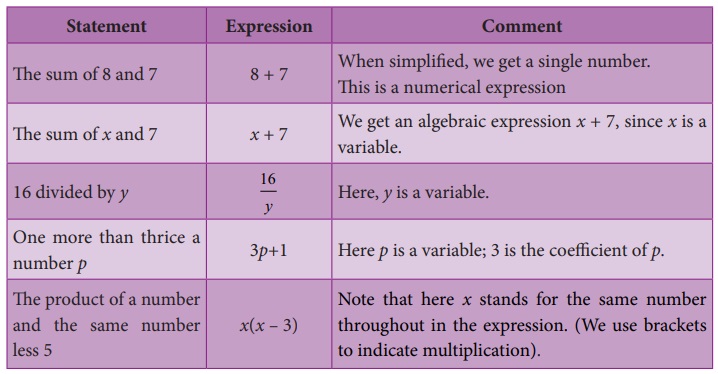
3. Equations
An equation is a statement that asserts the equality of two expressions;
the expressions are written one on each side of an “equal to” sign.
For example:
2x + 7 = 17 is an equation (where x is a variable). 2x + 7 forms the Left Hand Side (LHS) of the equation and 17 is its Right
Hand Side (RHS).
Linear equations
An equation
containing only one variable with its highest power as one is called a linear equation.
Examples: 3x – 7 = 10.
Linear equations in one or more variables:
An equation
is formed when a statement is put in the form of mathematical terms.
Here are
some examples:
(i) A number is added to
5 to get 25
This statement
can be written as x + 5 = 25.
This equation
x + 5 = 25 is formed by one variable (x) whose highest power is 1. So it is called
a linear equation in one variable.
Therefore,
an equation containing only one variable with its highest power as one is called
a linear equation in one variable.
Examples: 5x
−
2 =
8, 3y + 24 = 0
This linear
equation in one variable is also known as simple equation.
(ii) Sum of two numbers
is 45
This statement
can be written as x + y = 45.
This equation
x + y = 45 is formed by two variables x and y whose highest power
is 1. Hence, we call it as a linear equation in two variables.
Now, in this
class we shall learn to solve linear equations in one variable only. You will learn
to solve other type of equations in higher classes.
Note
The equations so formed with power more than 1 of its variables,
(2,3....etc.) are called as quadratic, cubic equations and so on.
Examples: (i) x2 + 4x + 7 = 0 is a quadratic equation.
(ii) 5 x3 − x2
+ 3x = 10 is a cubic equation.
Try these
Identify which among the following are linear equations.
(i) 2 + x = 19
(ii) 7x2 – 5
= 3
(iii) 4p3 =
12
(iv) 6m+2
(v) n=10
(vi) 7k – 12= 0
(vii)
6x/8 + y = 1
(viii) 5 + y = 3x
(ix) 10p+2q=3
(x) x2–2x–4
Convert the following statements into
linear equations:
Example 3.28
7 is added
to a given number to give 19.
Solution:
Let the number
be n.
When 7 is
added to this number we get n + 7.
This result
is to give 19.
Therefore,
the equation is n + 7 = 19.
Think
(i) Is t(t – 5)=10 a linear e quation? Why?
Solution:
t(t − 5) = 10
= (t × t) – (5 × t) = 10
= t2 − 5t = 10
This is not a linear equation as the highest degree of the
variable ‘t’ is 2
(ii) Is x2 =2x
, a linear equation? Why?
Solution:
x2 = 2x
= x2 − 2x = 0
This is not a linear equations as the highest degree of the
variable ‘x’ is 2
Example 3.29
The sum of
4 times a number and 18 is 28.
Solution:
Let the number
be x.
4 times the
number is 4x.
Adding 18
now, we get 18 + 4x.
Now the result
should be 28.
Thus, the
equation has to be 18 + 4x = 28.
Try these
Convert the following statements into linear equations:
• On subtracting 8 from the product of 5 and a number, I get 32.
Solution:
Convert to linear equations:
Given that on subtracting 8 from product of 5 and a, we
get 32
∴ 5 × x − 8 = 32
∴ 5x − 8 = 32
• The sum of three consecutive integers is 78.
Solution:
Sum of 3 consecutive integers is 78
Let 1st integer be ‘x’
∴ x + (x +
1) + (x + 2) = 78
∴ x + x + l +
x + 2 = 78
3x + 3 = 78
• Peter had a Two hundred rupee note. After buying 7 copies of a
book he was left with ₹60.
Solution:
Let cost of one book be ‘x’
∴ Given that 200 −7 × x = 60
∴ 200 − 7x = 60
• The base angles of an isosceles triangle are equal and the vertex angle measures 80°.
Solution:
Let base angles each be equal to x & vertex bottom
angle is 80°. Applying triangle property, sum of all angles is 180°
∴ x + x + 80 = 180°
∴ 2x + 80 =
180
• In a triangle ABC, ∠A is 10o more
than ∠B. Also ∠C is three times ∠A. Express the equation in terms of angle B.
Solution:
Let ∠B = b
Given ∠A = 10° + ∠B = 10 + b
Also given that ∠C = 3 × ∠A = 3 × (10 + b) =
30 + 3b
Sum of the angles = 180°
∠A + ∠B + ∠C = 180°
10 + b + b + 30 + 3b = 180°
∴ 5b + 40 =
180°
4. Solution
of a linear equation
The value
which replaces a variable in an equation so as to make the two sides of the equation
equal is called a solution or root of the equation.
Example : 2 x = 10
We find that
the equation is “satisfied” with the value x
= 5. That is, if we put x = 5, in the
equation, the value of the LHS will be equal to the RHS. Thus x = 5 is a solution of the equation. Note that no other value for x satisfies the equation. Thus one can say
x = 5 is “the” solution of the equation.
(i) The DO-UNDO Method:
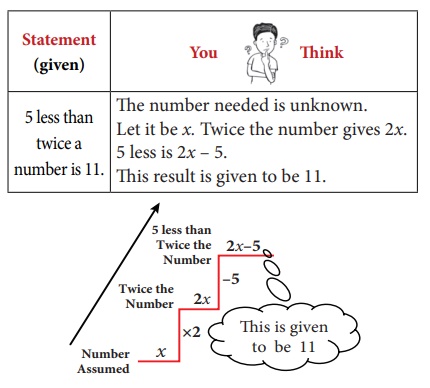
This formation of equation can be visualized as follows:
From the
number x, we reached 2x – 5 by performing operations like subtraction,
multiplication etc. So when 2x – 5 = 11
is given, to get back to the value of x,
we have to 'undo'
all that we did! Thus, we ‘do’ to form the equation and ‘undo’ to get the solution.
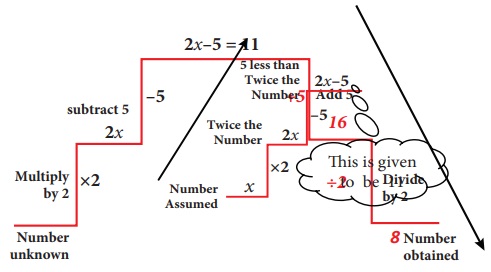
Example 3.30
(a)
Solve the equation: x − 7 = 6
Solution:
x –
7 = 6 (Given)
x –
7 +7 = 6+7 (add 7 on both sides)
x =
13
(b)
Solve the equation: 3x = 51
Solution:
3x = 51 (Given)
3 × x = 51
3/3 × x/3 = 51/3 (÷
3 on both sides)
x = 17
(ii) Transposition
method
The
shift ing of a number from one side of an equation to other is called
transposition.
For the above example, (a) doing addition of 7 on both sides is the same as changing the number –7 on the left hand side to its additive inverse +7 and add it on the right hand side.
x – 7 = 6

x = 6+7
x = 13
Think
Can you get more than one solution for a linear equation?
Solution:
Yes, we can get. Consider the below line or equation
x + y = 5
here, when x = 1, y = 4
when x = 2, y = 3
x = 3, y = 2
x = 4, y = 1
Hence, we get multiple solutions for the same linear equation.
likewise,
(b) doing division by 3 on both sides is the same as changing the number 3 on
the LHS to its reciprocal 1/3 and multiply it on the RHS and vice-versa.
For Example
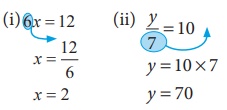
Note
While rearranging the given linear equation, group the like terms on one side of the equality sign, and then do the basic arithmetic operations according to the signs that occur in the expression.
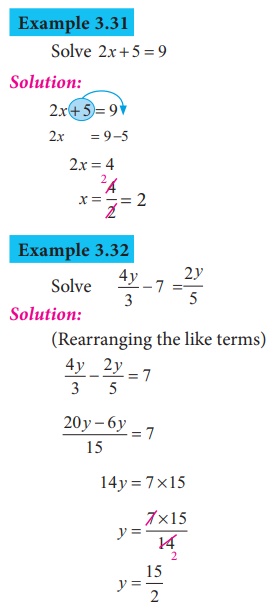
Try these
1. Solve for ‘x’ and
‘y’
(i) 2x = 10
(ii) 3 + x = 5
(iii) x – 6 = 10
(iv) 3x + 5 = 2
(v) 2x/7 = 3
(vi) –2 = 4m – 6
(vii) 4(3x – 1) = 80
(viii) 3x – 8 = 7 – 2x
(ix) 7 – y = 3(5 – y)
(x) 4(1 – 2y)–2(3 – y) = 0
Solution:
(i) 2x = 10
⇒ x = 10 / 2 = 5
(ii) 3 + x =
5
⇒ 3 + x = 5
x = 5 – 3 = 2
(iii) x − 6
= 10
⇒ x − 6 = 10
x = 10 + 6 = 16
(iv) 3x + 5
= 2
⇒ 3x + 5 = 2
3x = 2 – 5 = − 3
x = −3/3 = −1
(v) 2x/7 = 3
⇒ 2x = 3 × 7 = 21
x = 21/2
(vi) − 2x =
4m − 6
⇒ − 2x = 4m − 6
−2 + 6 = 4m
4 = 4m
m = 4 / 4 = 1
(vii) 4(3x −
1) = 80
⇒ 4(3x − l) = 80
12x − 4 = 80
12x = 80 + 4 = 84
x = 84 / 12 = 7
(viii) 3x − 8
= 7 − 2x
⇒ 3x − 8 = 7 − 2x
3x + 2x = 7 + 8 = 15
5x = 15
x = 15/5 = 3
(ix) 7 − y =
2(5 − y)
⇒ 7 − y = 3(5 − y)
7 − y = 15 − 3y
3y − y = 15 − 7
2y = 8
y = 8 / 2 = 4
(x) 4(l − 2y)
− 2(3 −y) = 0
⇒ 4(1− 2y) – 2(3 − y) = 0
4 − 8y − 6 – 2y = 0
−2 − 6y = 0
6y = − 2
y = − 2 / 6 = −1 / 3
Think
1. “An equation is multiplied or divided by a non zero number on
either side.” Will there be any change in the solution?
Solution:
Not be any change in the solution
2. “An equation is multiplied or divided by two different numbers
on either side”. What will happen to the equation?
Solution:
When an equation is multiplied or divided by 2 different numbers
on either side, there will be a change in the equation & accordingly,
solution will also change.